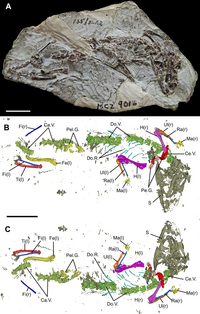Sphenodontidae
| Sphenodontidae Temporal range:
| |
|---|---|

| |
| Tuatara (Sphenodon punctatus) | |

| |
| Skeleton of Sphenofontis, a sphenodontine from the Late Jurassic of Germany | |
| Scientific classification | |
| Kingdom: | Animalia |
| Phylum: | Chordata |
| Class: | Reptilia |
| Order: | Rhynchocephalia |
| Suborder: | Sphenodontia |
| Family: | Sphenodontidae Cope, 1870 (conserved name) |
| Type species | |
| Hatteria punctata Gray, 1842
| |
| Subgroups | |
| |
| Synonyms | |
| |
Sphenodontidae is a family within the reptile group Rhynchocephalia, comprising taxa most closely related to the living tuatara of the genus Sphenodon. Historically the taxa included within Sphenodontidae have varied greatly between analyses, and the group has lacked a formal definition.[2] Cynosphenodon from the Early Jurassic of Mexico has consistently been recovered as a close relative of the tuatara in most analyses, with the clade containing the two often called Sphenodontinae.[2] The herbivorous Eilenodontinae, otherwise considered part of Opisthodontia, is also sometimes considered part of this family as a sister group to the remaining Sphenodontinae. Sphenodontines first appeared during the Early Jurassic, and are characterised by a complete lower temporal bar caused by the fusion of the quadrate/quadratojugal and the jugal, which was an adaption for reducing stress in the skull during hard biting.[3] Like modern tuatara, members of Sphenodontinae were likely generalists with a carnivorous/insectivorous diet.[4]
References
- ^ Apesteguia RO, Rougier GW (2012). "A basal sphenodontian (Lepidosauria) from the Jurassic of Patagonia: new insights on the phylogeny and biogeography of Gondwanan rhynchocephalians". Zoological Journal of the Linnean Society. 166 (2): 342–360. doi:10.1111/j.1096-3642.2012.00837.x. [R. Benson/R. Benson]
- ^ a b Simões TR, Caldwell MW, Pierce SE (December 2020). "Sphenodontian phylogeny and the impact of model choice in Bayesian morphological clock estimates of divergence times and evolutionary rates". BMC Biology. 18 (1): 191. doi:10.1186/s12915-020-00901-5. PMC 7720557. PMID 33287835.
- ^ Simões, Tiago R.; Kinney-Broderick, Grace; Pierce, Stephanie E. (2022-03-03). "An exceptionally preserved Sphenodon-like sphenodontian reveals deep time conservation of the tuatara skeleton and ontogeny". Communications Biology. 5 (1): 1–19. doi:10.1038/s42003-022-03144-y. ISSN 2399-3642.
- ^ Villa, Andrea; Montie, Roel; Röper, Martin; Rothgaenger, Monika; Rauhut, Oliver W. M. (2021-05-03). "Sphenofontis velserae gen. et sp. nov., a new rhynchocephalian from the Late Jurassic of Brunn (Solnhofen Archipelago, southern Germany)". PeerJ. 9: e11363. doi:10.7717/peerj.11363. ISSN 2167-8359.
Error: "Q3493224" is not a valid Wikidata entity ID.
- Articles with short description
- Articles with 'species' microformats
- Taxonbars desynced from Wikidata
- Taxonbar pages requiring a Wikidata item
- Taxonbars with invalid from parameters
- Taxonbars without secondary Wikidata taxon IDs
- Sphenodontia
- Taxa named by Edward Drinker Cope
- Reptile families
- Extant Early Jurassic first appearances
- Toarcian first appearances
- Toarcian taxonomic families
- Aalenian taxonomic families
- Bajocian taxonomic families
- Bathonian taxonomic families
- Callovian taxonomic families
- Oxfordian taxonomic families
- Kimmeridgian taxonomic families
- Tithonian taxonomic families
- Berriasian taxonomic families
- Valanginian taxonomic families
- Hauterivian taxonomic families
- Barremian taxonomic families
- Aptian taxonomic families
- Albian taxonomic families
- Cenomanian taxonomic families
- Turonian taxonomic families
- Coniacian taxonomic families
- Santonian taxonomic families
- Campanian taxonomic families
- Maastrichtian taxonomic families
- Danian taxonomic families
- Selandian taxonomic families
- Thanetian taxonomic families
- Ypresian taxonomic families
- Lutetian taxonomic families
- Bartonian taxonomic families
- Priabonian taxonomic families
- Rupelian taxonomic families
- Chattian taxonomic families
- Aquitanian taxonomic families
- Burdigalian taxonomic families
- Langhian taxonomic families
- Serravallian taxonomic families
- Tortonian taxonomic families
- Messinian taxonomic families
- Zanclean taxonomic families
- Piacenzian taxonomic families
- Gelasian taxonomic families
- Calabrian taxonomic families
- Ionian taxonomic families
- Tarantian taxonomic families
- Holocene taxonomic families
- All stub articles
- Reptile stubs

